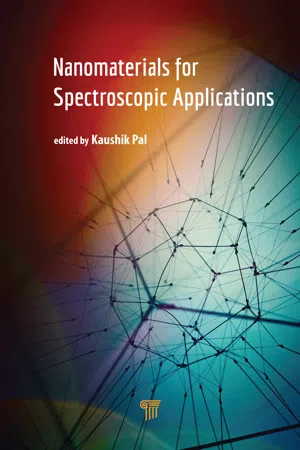
- 358 pages
- English
- ePUB (mobile friendly)
- Available on iOS & Android
Nanomaterials for Spectroscopic Applications
About this book
This book provides an overview of key current developments in the synthetic strategy of functional novel nanomaterials in various spectroscopic characterizations and evaluations and highlights possible future applications in nanotechnology and materials science. It illustrates the wide-ranging interest in these areas and provides a background to the later chapters, which address the novel synthesis of high-yield nanomaterials and their biomaterials, graphene, polymeric nanomaterials, green nanomaterials, green polyester, liquid crystal electro-optic switching applications, nanobiotechnology, transition metal oxides, response characteristics of exclusive spectroscopic investigation as well as electron microscopic study, flexible and transparent electrodes, optoelectronics, nanoelectronics, smart displays, switchable device modulation, health care, energy storage, solar/fuel cells, environmental and plant biology, social, ethical, and regulatory implications of various aspects of green nanotechnology, as well as significant foreseeable spectroscopic applications of key functional nanomaterials. Given appropriate regulation for and research on the topics covered, commercial production of manufactured novel composite materials can be realized. Furthermore, the many discoveries highlighted in the book can modulate spectroscopic performances with technical excellence in multidisciplinary research of high competence.
Frequently asked questions
- Essential is ideal for learners and professionals who enjoy exploring a wide range of subjects. Access the Essential Library with 800,000+ trusted titles and best-sellers across business, personal growth, and the humanities. Includes unlimited reading time and Standard Read Aloud voice.
- Complete: Perfect for advanced learners and researchers needing full, unrestricted access. Unlock 1.4M+ books across hundreds of subjects, including academic and specialized titles. The Complete Plan also includes advanced features like Premium Read Aloud and Research Assistant.
Please note we cannot support devices running on iOS 13 and Android 7 or earlier. Learn more about using the app.
Information
1.1 Introduction

1.2 Liquid Crystalline Materials by Nanodopants
Table of contents
- Cover
- Half Title
- Title Page
- Copyright Page
- Table of Contents
- Preface
- 1 An Emerging Avenue of Functional Graphene Aggregated Liquid Crystalline Hybrid Nanocomposite Diverse Attempts: Key Challenges and Novel Premises
- 2 Spectroscopic and Microscopic Response of Graphene/CNTs Based Nanomaterials
- 3 Thermotropic Hydrogen-Bonded Liquid Crystals (HBLCs) Spectral Analysis of Phase Transition: Limitations, Perspectives and Challenges
- 4 Green Nanostructures Synthesis and Spectroscopic Characterizations
- 5 Synthesis, Designing and Challenges of Functionalized Polymeric Nanomaterials and Their Spectroscopic Applications
- 6 Fabrication of Ultra-Pure Anisotropic Nanoparticles, Spectroscopic Studies and Biological Applications
- 7 Bioinspired Nanomaterials for Improving Sensing and Imaging Spectroscopy
- 8 Green Nanomaterials: Synthesis, Properties and Spectroscopic Applications
- 9 Functional Green Nanomaterials Designing Approach to Spectroscopic Evaluation
- 10 Green Chemistry Assisted Synthesis of Metallic Nanomaterials Applications
- 11 Preparation of Metal Nanoparticles Extractions from Green Natural Products
- 12 Ostwald Ripening of PDIF-CN2 Molecules on Bilayer and Multilayer Graphene
- Index